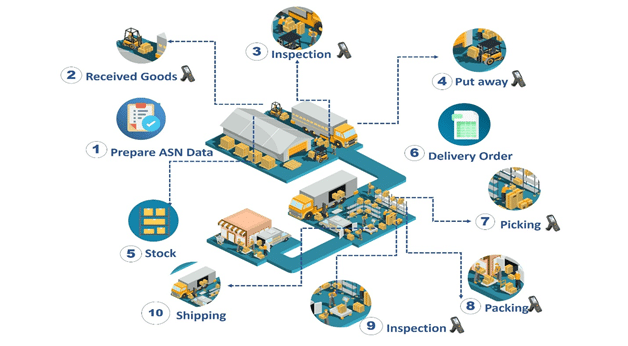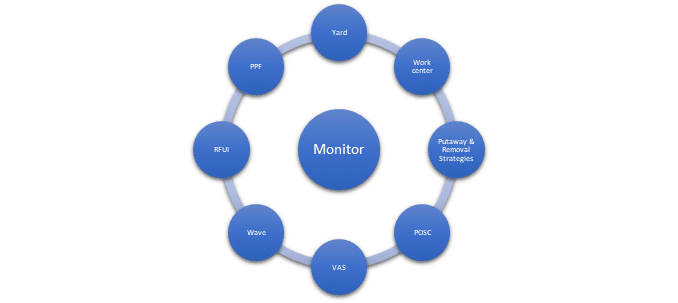SAP EWM Proper Guide for Optimizing Your Warehouse and Supply Chain
The ever-rising competition in e-commerce has put unprecedented pressure on companies to maintain seamless supply chains. Globally, companies spend an average of €300 billion annually on warehouse management by outsourcing to a third party or managing in-house. Today’s consumers expect instant delivery of products, and to cater to their demands, companies must optimize end-to-end warehouse management.
Efficient management of the warehouses shortens the total turnaround time TAT in delivering the products to consumers. In the seamless functioning of the supply chain, warehouses play a kingpin role in connecting the first mile with the last mile. Thus, it becomes imperative for companies to increase their efficiency and automate their complete inventory processes with an effective warehouse management system.
So, managing warehousing has evolved as an essential marketing strategy of the leadership teams to reap optimum benefits from the business.
As per Statista, globally, the automation market in the warehouse domain is expected to surpass 30 billion US dollars. The Zebra warehousing vision study predicts more than 80% of organizations worldwide are planning to augment the work efficiency of warehouses through technological upgradation. And more than 27% have already designed to automate their warehouse to make it more intelligent, better integrated, comprehensive, and cost-effective by 2024.

Warehousing – The Complexity
Over the last two decades, the warehousing function has evolved from a mere storage process to a strategic business part of delivering good customer experience (CX) and retaining them for a long time.
Modern production and marketing trends have pushed the warehousing function to expand its boundaries regarding volumes processed and the activities performed.
As the warehouses continued to perform activities other than the traditional warehousing activities, such as product processing, value-added-services, cross-docking, etc., the complexity of warehouse management also increased, and so did the need for an effective warehouse management system capable of optimizing end-to-end warehousing activities.
Why SAP EWM?
Maintaining the same supply chain flow 24*7 and handling its operational complexities are some of the prominent reasons companies choose SAP EWM. There are scores of reasons involved with supply chain logistics and warehouse management that compel companies to opt for SAP EWM. Some reasons are that a company wants to manage its inventory in a decentralized environment that can seamlessly connect with other functions of ERP for order (inbound/outbound) processing and data sharing; an organization wants to track the exact location of its inventory throughout the supply chain; and more.
However, the most prominent reason for electing SAP EWM is its tight integration with other ERP applications of SAP like SAP MM, SD, PP, QM, TM, etc. Non-ERP products like SAP CRM, SAP GTS, and more.
As a market leader in software solutions, SAP has already proven its mettle in warehouse management systems with its software, SAP WM. Its recent technological advancement and upgraded warehousing management—SAP EWM (Extended Warehouse Management)—is designed to resolve the increasing complexities of warehouse operations.
SAP has developed a robust, revamped, and advanced warehouse management system to cater to the needs of present-day warehousing. It has added much functional support for value-added services, cross-docking, physical inventory, transportation unit management, labor management, and more.
Functionality for Optimization:

Yard Management
From the warehousing point of view, the yard is located immediately outside the warehouse complex. This is a buffer zone to park the vehicles/transportation units before being docked to the warehouse doors for loading and unloading activities.
Yard management is a part of shipping and receiving products that help track and manage transportation units.
If the yard gets structured in line with other elements of the warehouse management systems, it streamlines various warehousing processes. The yard is a storage type, and other milestones like checkpoints, parking spaces, and doors are defined as storage sections and bins. Yard management functionality provides the flexibility to track the inventory status from right outside the warehouse complex and thus optimizes the workflow accordingly.
The advantages of yard management include the 360-degree visibility of inventory, its exact location in the supply chain, optimization of inbound and outbound delivery processing at the transportation unit level, and much more.
Work Center to Execute the Processing Tasks
A work center is a physical unit of the warehouse that acts as an interim storage type during the inbound and outbound workflows. Various processing activities are performed at this stage, like deconsolidation, packing, quality inspection, and value-added services.
According to the transactional needs, various functions can be included and excluded in the layout of the Work Center, like HU creation, Repack HU, Change HU, Deconsolidate, Quality Inspection, and VAS.
Strategies to Optimize Putaway and Picking
During the Putaway process, users can strategically enable the determination of the destination bin according to the product attributes and storage needs. Similarly, he can make strategies during the picking process to determine the source bin for picking the products during the outbound process.
Strategies work by sequentially searching for the appropriate bin (destination/source) according to the predefined control parameters like process type, quantity classification, stock type, product hazard rating, etc.
This search sequence can further be optimized by prioritizing the multiple combinations of control parameters.
POSC to Streamline Multi-Step Putaway or Picking Process

POSC stands for Process-Oriented Storage Control and was introduced in EWM to streamline the complex multi-step putaway or pick process. It simplifies the process in which the product goes through multiple processing stages like deconsolidation, packing, and VAS until it gets placed in the destination bin.
In the POSC functionality, all the relevant processing stages are defined in a multistep sequential storage process, and the storage process gets assigned to the appropriate warehouse process type. So, the system automatically moves the products to the next stage in the sequence once the activity at the first stage is finished.
POSC functionality works only for products packed in the handling unit.
VAS to Execute the Value-Added Service Tasks
VAS functionality automates the process of value-adding activities like labeling, adding protective packaging material, oiling, etc.
As part of this functionality, product group types and product groups are assigned to the product master records of relevant products. The control parameters maintained in the VAS relevance settings determine the document type (inbound/outbound, etc.) as per the VAS order to be triggered.
A packaging specification maintained concerning VAS condition type specifies the VAS activity that needs to be performed.
When the system triggers the VAS order concerning VAS relevance settings, activity on the products is performed according to the existing packaging specification.
Wave to Bring Efficiency in Outbound Delivery Processing

Wave functionality is provided to collectively process the outbound delivery orders by grouping them based on the route, product, and ship-to-party parameters.
When the wave management functionality is active, its outbound warehouse request items get grouped according to the route, product, and ship-to-party combinations and processed further to create the warehouse tasks collectively. Managing the outbound delivery orders in waves results in faster order processing and better resource utilization.
RF Framework for Mobile Data Capturing
The Radio Frequency framework available on SAP enables us to design and customize the functionality of mobile data-capturing devices based on the users’ or resources’ activities.
The use of RF devices accelerates the execution of warehouse tasks because of the mobility they provide in data capturing. It supports real-time data communication between the central EWM system and the user.
Post-Processing Framework for System Efficiency
The post-processing framework enhances the SAP EWM platform. It is used in delivery processing, shipping, receiving, printing, and triggering actions related to printing labels and sending emails. It is also helpful in managing the follow-up actions (automatic warehouse task creation) in the background.
The actions get triggered automatically when the conditions are met, automating workflows and follow-on functions.
Monitor
In EWM, the monitor acts as a dashboard with 360-degree visibility of the stock movements in a warehouse: both inbound and outbound delivery transactions, stock availability, resource management, and product master.
The monitor gives excellent control over the warehouse operations for managers, as all the data is centrally available for analysis and research.
Apart from this, advanced functionality like labor management tracks and analyzes the performance of the warehouse resources. It helps cross-dock the products and makes the inbound delivery products available directly for outbound order processing without storing them.
Key Business Benefits:
EWM offers the business a wide range of benefits with its improved and advanced functionality to optimize and automate the warehouse’s end-to-end workflows.
- Radio Frequency Framework (RFF) can speed up task execution by up to 30%.
- RFF enables the seamless data flow between RF devices and central data processing terminals.
- Improve operational efficiency and reduce costs with automated workflows and efficient resource utilization.
- WAVE functionality helps achieve customer satisfaction by accelerating order fulfillment by up to 40%.
- Improve the productivity of the resources/employees by measuring their performance through labor-management functionality.
- The centralized monitoring system provides complete visibility of stock and operations throughout the warehouse.
- It provides the capability to seamlessly integrate with the other ERP functionality to gain overall efficiency in the supply chain.
According to Gartner, SAP EWM is “smart, best, and efficient warehouse management software that incredibly well streamlines the inventory management tool.”
To summarize, in the rapidly growing supply chain industry, a warehouse is regarded as a key player in enhancing the efficiency of overall supply chains. So, with a warehouse management system, leverage the optimum benefits of warehousing and get an edge over the competition. Sap’s EWM does precisely what is needed in this regard.
Cigniti’s Expertise as Quality Assurer
Adopting a shit-left testing approach in the software development life cycle is always recommended to identify and fix defects early during the development sprints. It saves the developer time and effort and thus enhances testing efficiency.
A dedicated testing partner who is well acquainted with deep domain knowledge work is a must to onboard for the successful running of the organization. Testing partners must have expertise in testing phases like unit testing, SIT, performance testing, and UAT.
Cigniti, the world’s leader in the testing domain, ensures the thorough testing of the SAP EWM functionalities. We are committed to assisting our customers with a smooth onboarding of the SAP EWM, whether starting from scratch or migrating from SAP WM. Validate the software performance beforehand with us.
Cigniti has a proven track record of handling independent quality engineering and software testing services. We can be your valued partner in building your organization’s best-in-class warehouse management system. Talk to our experts!





Leave a Reply